What Is Nanomanufacturing?
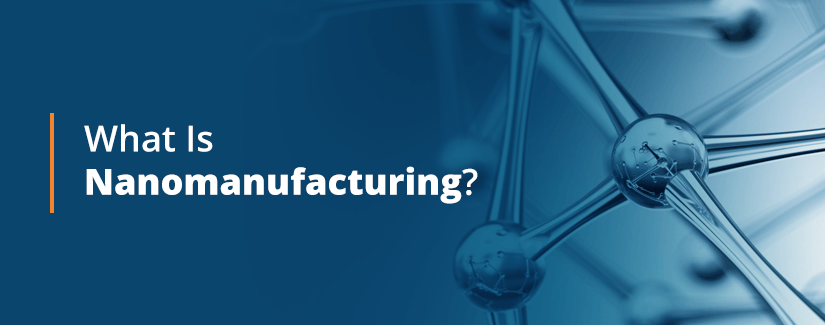
For centuries, product makers have relied on the natural properties of numerous materials to bring product concepts into existence. If the product required a solid form or protective exterior, materials were selected at face value to fulfill those requirements. If the product needed fluidity or elasticity, materials or chemicals were chosen based on how they tested for those qualities. Only recently have manufacturers considered the possibility of enhancing or altering various materials at the nanoscale.
What Is Nanomanufacturing?

Nanomanufacturing is a set of industrial processes based on nanotechnology, where products are developed at the nanoscale. The nanoscale includes items measuring from one to 100 nanometers, where one nanometer is a billionth of a meter. In nanomanufacturing, products can be developed from two basic approaches:
- Bottom-up nanomanufacturing: The process of building products from molecular components. Projects of this sort tend to be time-consuming due to the innumerable elements required to create a given product.
- Top-down nanomanufacturing: The process of developing products from whole pieces of material, such as those carved from wood or molded from metal alloys. Though more straightforward than the bottom-up approach, this method can be more wasteful due to all the material that ends up on the cutting-room floor by the time the final product takes shape.
Various processes have been developed under the categories of bottom-up and top-down nanomanufacturing. Some of the more common procedures include the following:
- Chemical vapor deposition (CVD): This process is used to make materials from a series of chemical reactions. CDV is often employed in the semiconductor industry, where it is used to create film strips with silicone, carbon and filaments.
- Molecular-beam epitaxy (MBE): A process used to deposit thin films.
- Atomic layer epitaxy (ALE): A process where layers comprised of single-atom thickness are deposited onto surfaces.
- Dip-pen nanolithography (DPN): In a process that resembles the functions of an ink pen, DPN involves the use of a chemically saturated microscopic tip, which is used to write on surfaces. A lithograph that heats above 100°C is capable of fabricating metal electrodes far more effectively than a conventional electron beam.
- Nanoimprint lithography (NIL): A nanoscale stamping process where features are imprinted onto a surface.
- Roll-to-roll processing: A process where ultrathin strips of metal and plastic are imprinted with nanoscale devices at a rapid frequency.
- Self-assembly: A set of processes where different elements are brought together without intervention to form a structure.
Each one of these processes can be used to enhance the structure of a material.
Nanotechnology has given manufacturers new and improved ways to produce materials of varying strengths and thicknesses that are water-resistant, self-cleaning and abrasion-proof. These materials can be rendered electronically conductive and resistant to infrared and ultraviolet rays.
Products manufactured in part by nanotechnology include sporting items such as baseball bats and tennis rackets, which feature materials constructed at the nanoscale. Nano processes have also been used in the refinement of crude oil and the detection of toxins.

In the decades ahead, nanoscale transistor technology may allow computer manufacturers to develop machines that will function much faster than those used today. Proponents of the technology predict that nanoscale processes will one day allow developers to store massive amounts of computer energy onto single chips.
The energy sector is also expected to develop new ways of storing electrical energy with nanotechnology, which could one day allow for energy storage on solar cells. As such, battery manufacturers could use nanoscale methods to produce highly efficient, low-cost batteries.
The processes used in nanomanufacturing require advanced equipment and complex system arsenals. At present, most manufacturers who embrace nanoscale processes are doing so by using National Nanotechnology Initiative (NNI) resource centers, which provide equipment and help staff at more than 90 facilities across the U.S.
Why Is It Important?
Nanoscale particles have existed forever and have long been recognized in the scientific community. Thanks to recent developments in microscopy, scientists can now examine molecular elements and determine how different properties organize at the nanoscale.
Knowing that natural phenomenon happens at the nanoscale, manufacturers are using research in this field to develop new and improved methods for printing, computing and medicinal formulation. By seeing elements at the molecular level, researchers can determine the physical and chemical phenomenon that occurs at a microscopic scale among different material properties.
The benefits of nanotechnology are rooted in the quantum effects that particles undergo at the super-microscopic level. Even though a standard microscope will not reveal this phenomenon, nanoscale analysis allows scientists to observe the physical and chemical reactions of various particles to electricity, heat and magnetic forces.
One of the most exciting discoveries in nanotechnology has been the appearance of gold at the nanoscale. While gold is known for its metallic yellow color, nanoscale particles of gold will often have a reddish or purplish appearance. This indicates that light has a different effect on gold at the nanoscale than on a piece of gold as a whole. Doctors can use this discovery to isolate the nanoscale gold particles on tumors from healthy surrounding cells.
Scientists can also use nanoscale processes to alter the size of particles. This makes it possible to improve material and also create markers at the nanoscale. For example, a fluorescent particle can be modified to stand out from a set of particles or used as an identifying marker.
Some of the key biological components of the human body are measured most accurately at the nanoscale. The average strand of DNA has a diameter of roughly 2 nanometers, while the diameter of hemoglobin is approximately 5.5 nanometers. Medical researchers are using nanoscale analysis to develop medicines and treatments that are more precise and personalized than the more generalized, pre-existing ones currently in use.
Compared to other scales, nanoparticles have relatively large surface areas. Changes in reactivity occur when surface areas increase and come into contact with each other. Knowing this, nanomanufacturers have developed better catalysts. In the auto industry, nanotechnology has been used to create batteries, fuel cells and converters that yield higher efficiency.
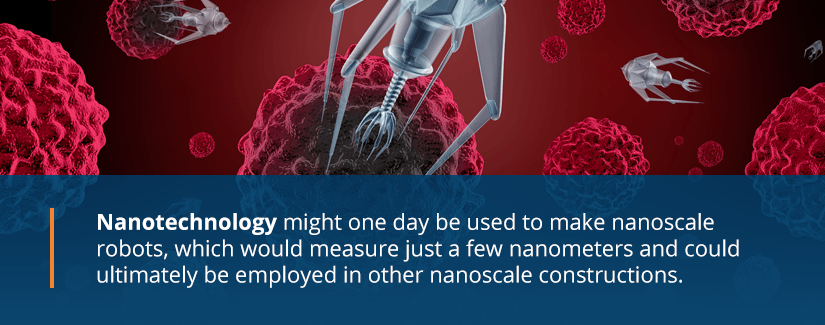
Nanotechnology might one day be used to make nanoscale robots, which would measure just a few nanometers and could ultimately be employed in other nanoscale constructions. In the decades ahead, nanomanufacturing could streamline numerous processes in many fields and, in doing so, eliminate the need for various skill sets and bring an end to certain occupations.
How Was It Developed?
In the pre-modern world, artisans understood that heat could manipulate the properties of sculpting materials like glass. This process represented some of the earliest manipulations of particles at the nanoscale, as employed in the making of ancient artifacts like the Lycurgus Cup, a dichroic glass sculpture from 4th century Rome. The cup appears solid green if lit from the outside and translucent red if lit from the inside. This is due to the gold and silver properties within the glass, which reveal different colors at the nanoscale.
Between the 9th and 17th centuries, ceramic plates molded by European and Middle Eastern sculptures included silver and copper nanoparticles. Cathedrals built in Europe between the 6th and 15th centuries feature stained glass windows that contain metallic particles, which give these windows their color.
Between the 13th and 18th centuries, swords made of Damascus steel contained carbon nanotubes that made these blades strong and shiny.
1850 – 1949
As the Industrial Revolution got underway, scientists made some fundamental discoveries that would ultimately serve as building blocks in nanotechnology:
- 1857: British scientist Michael Faraday discovers that gold can appear in different colors if subjected to certain lighting.

- 1936: German physicist Erwin Müller constructs the first field emission microscope, which makes it possible to examine particles at the molecular level.
- 1947: Three scientists working at Bell Labs created the first semiconductor transistor, which sets the groundwork for modern-day electronics.
- 1950: American chemist Victor La Mer and partner Robert Dinegar discover a way to fabricate colloids. This would have a significant impact on the production of paint, paper and film. The discovery would also prove vital in dialysis treatment.
These and other developments paved the way for the era where many homes had appliances and electronics.
1950 – 1999
As the Industrial Revolution gave way to the Computer Age, developments in nanotechnology occurred more rapidly:
- 1951: Müller develops the first field ion microscope, which creates images of atom clusters at the tip of sharp metal objects. He used this to study the arrangement of tungsten atoms.
- 1956: German-American physicist Arthur von Hippel develops the concept of molecular engineering, which would ultimately be applied in the areas of dielectrics, ferroelectrics and piezoelectrics.
- 1958: Jack Kilby develops the first integrated circuit, a set of electrical circuits on semiconductor material. This would form the basis of modern-day computer boards. Kilby was given a Nobel Prize for this invention in 2000.
- 1965: In an interview with Electronics magazine, Intel co-founder Gordon Moore foretells several future trends that would pan out in the decades ahead, including the prediction that the density of transistor chips would double every two years in inverse proportion to costs. Over the next half-century, this trend — known today as Moore’s Law — would be facilitated by nanotechnology, which has made it possible for computer manufacturers to produce transistors with microscopic dimensions.
- 1974: Professor Norio Taniguchi of Tokyo Science University first uses the term “nanotechnology” to define microscopic-level machining of material tolerances.
- 1981: The German/Swiss physicist team of Gerd Binnig and Heinrich Rohrer develop the scanning tunneling microscope, which makes it possible to view spatial images of individual atoms. Five years later, the pair would be awarded a Nobel Prize for their invention.
- 1981: Russian physicist Alexei Ekimov discovers nanocrystalline material.
- 1985: A team of chemists at Rice University discovers the Buckminsterfullerene (C60) — colloquially referred to as the buckyball — a cluster of carbon atoms that resembles a soccer ball. The team would win a Nobel Prize for their discovery in 1996.
- 1985: Chemist Louis Brus discovers colloidal semiconductor nanocrystals — also known as quantum dots — while working at Bell Labs.
- 1991: Japanese physicist Sumio Iijima makes the first verified discovery of the carbon nanotube (CNT), which is described as a tubular equivalent of the buckyball. The strength and conductivity of CNT will make it a crucial discovery for nanotechnology.
- 1992: Chemist C.T. Kresge of Mobile Oil discovers MCM-41 and MCM-48, two nanostructured catalytic materials widely used today for the refinement of crude oil and the treatment of water.
- 1999: Chemist Chad Mirkin invents dip-pen nanolithography®, which becomes widely adopted for electronic writing and biomaterial patterning.
Despite the many technological developments of the 20th century, the new millennium would see rapid advances as nanotechnology made its way into manufacturing.
2000 and Beyond
During the early 2000s, products enhanced with nanotechnology first appeared on the market. Examples included scratch-proof and dent-resistant bumpers, straight-flying golf balls, super-flex baseball bats, transparent sunscreen lotions, stain-proof apparel, anti-scratch glass coats and other products of high resilience.
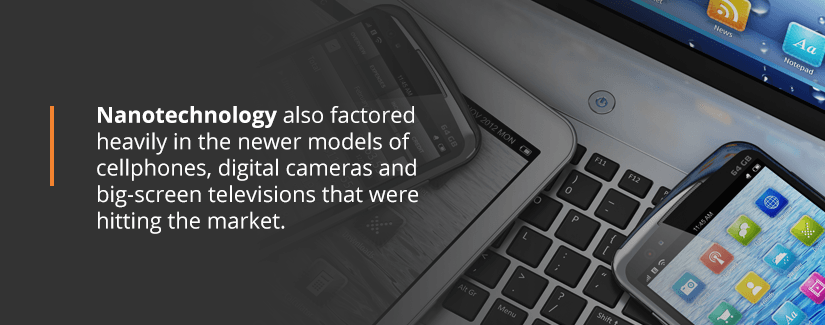
Nanotechnology also factored heavily in the newer models of cellphones, digital cameras and big-screen televisions that were hitting the market. In light of these developments, the government stepped in to spur progress at the nanoscale level:
- 2000: President Bill Clinton enacts the National Nanotechnology Initiative (NNI) to promote domestic nanoscale competition.
- 2003: Congress passes the 21st Century Nanotechnology Research and Development Act, designed to set up programs, secure funding and encourage research into nanotechnology.
During the 2010s, nanotechnology would help computer manufacturers develop faster, quieter, more compact PCs and laptops.
Who Is Using It?
Nanotechnology has led to numerous innovations that could easily feature in everyday cars, apparel and fluid products.
1. Automotive Industry

Automakers have embraced nanotechnology to improve the comfort of vehicles and the performance of engine and underside components. In today’s cars, vans, trucks and SUVs, nano-engineered materials have brought about the following improvements:
- Polymer nanocomposite parts: Today’s automobiles are stronger than ever thanks to nanotechnology, which has allowed automakers to construct auto-body parts that are resistant to scratches and dents. Previously, a minor rear-ending accident could ruin a bumper. On newer cars and trucks, bumpers can absorb certain degrees of impact and still hold shape.
- Rechargeable battery systems: Before, engine batteries would abruptly die, leaving motorists stranded in the middle of nowhere. Thankfully, today’s vehicles are equipped with battery systems that will recharge continually for high-powered performance. Newer automobiles are also equipped with dashboard warning lights that indicate when a battery is running low and needs to be recharged or switched out for a new one.
- Thermoelectric materials for temperature control: Modern cars and trucks are less likely to overheat thanks to nanocomposite materials, which absorb less heat. From the passenger compartment to the engine bed, the various parts that comprise a vehicle are less prone to store and spread heat to neighboring components. This makes rides more comfortable for passengers and safer for engine parts.
- Lower rolling-resistance tires: Today’s tires offer greater efficiency thanks to nanotechnology, which has allowed tire-manufacturers to improve the rolling capabilities of newer tires. This makes vehicles safer and more fuel efficient because the tires provide greater stability and produce a smoother roll with less stress on the wheels and axles.
- High-efficiency sensors and electronics: Nanotechnology makes it possible for electronics manufacturers to store large amounts of data, energy and artificial intelligence on tiny chips. As such, today’s cars, vans and trucks are equipped with smart technology like sensors to warn of encroaching traffic as well as decreasing fuel supplies. Nanoscale chip components have also led to the development of high-tech entertainment consoles for newer vehicles.
- Thin-film smart solar panels: Thanks to developments in solar panels, modern drivers can enjoy a range of features on long commutes without having to worry about battery loss. On bright and sunny days, a car can use solar energy to power the lights, air conditioning and sound system. When the engine battery needs a recharge, it too can rely on the sun for further supplies of energy.
- Fuel additives: Today’s fuels are more clean-burning and efficient thanks to nanoparticle additives, which make fuels easier on engine components. During a regular fuel cycle, the passing fluids leave only minor amounts of the trace elements that often had corrosive effects in older vehicles.
- Improved catalytic converters: Newer vehicles leave less of a carbon footprint than older cars and trucks, all thanks to recent improvements in catalytic converters, which emit fewer gases. In congested cities, this has led to a slow cleanup of the local air. As more and more motorists switch to newer vehicles, cities could become cleaner, and residents might experience fewer pollution-related health problems.
In the future, roads could become quieter, cleaner and safer due to automotive improvements made possible by nanotechnology.
2. Clothing
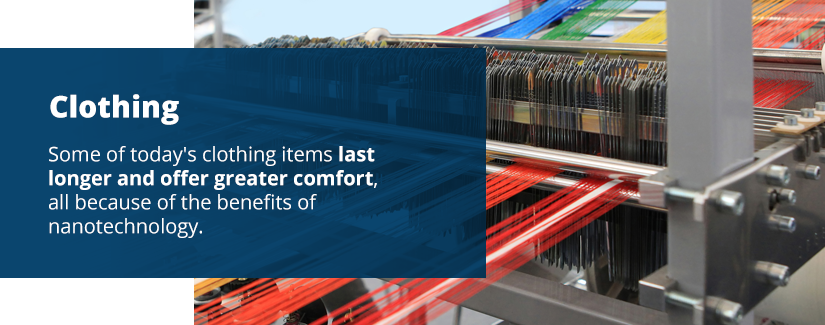
Some of today’s clothing items last longer and offer greater comfort, all because of the following benefits of nanotechnology:
- Wrinkle resistance: Many of today’s garments are less likely to wrinkle thanks to developments in nanotechnology among clothing manufacturers. Whether an item is fresh out of the dryer or bundled up in a drawer, it can generally be worn without ironing if the fabric is enhanced with anti-wrinkle nanoparticles. Best of all, these clothes are still made of comfortable cotton blends, making them wearable and convenient.
- Stain resistance: These days, spills at the dinner table are less troublesome thanks to nanotechnology, which has rendered many everyday clothing items stain-resistant. Even if you spill red wine onto a white shirt, it could still be wiped off without even the faintest trace of pink after the garment has dried.
- Antimicrobial: Fabrics made with nanotechnology are more resistant to fungal development. With no place within the fabric strands for tiny bacteria to nest and spread, clothing items remain cleaner and free of odor. This makes clothing items wearable for more extended periods and also prevents wearers from developing skin rashes that can sometimes stem from fabric bacteria.
Clothes with nano-enhanced materials could ultimately be worn for years and years by the same wearer.
3. Coatings

Nanostructured elements are used in various fluids for enhanced strength and effectiveness. Common products that have benefited from nanotechnology include the following:
- Ceramic glazes: Ceramics coated with nanostructured glazes are stronger and more resistant to scratches and general wear. Crockery glazed with these coatings are likelier to remain new in appearance, even after years of wash-and-rinse cycles.
- Paints: Paints with nanostructured ingredients provide stronger coats that resist scratches and rarely fade or crack, all without unwanted lumpiness or excess thickness.
- Skincare products: Nanoscale-enhanced lotions, creams and other skincare products offer higher levels of protection for the hands, body and face.
- Sunscreen lotion: With nanoscale titanium dioxide, sunscreen manufacturers can now offer products that are transparent on the skin, allowing users to safely sit and walk under the sunlight without any embarrassing discoloration.
Products coated with nanostructured products are less likely to need recoats, and those that do will require new coats on a less frequent basis.
When Will It Start Becoming Commonplace?
Nanotechnology is constantly being researched and developed at laboratories throughout the world. One development that could impact technology on numerous fronts is the ever-shrinking semiconductor, which grows faster and more efficient in inverse proportion to its size.
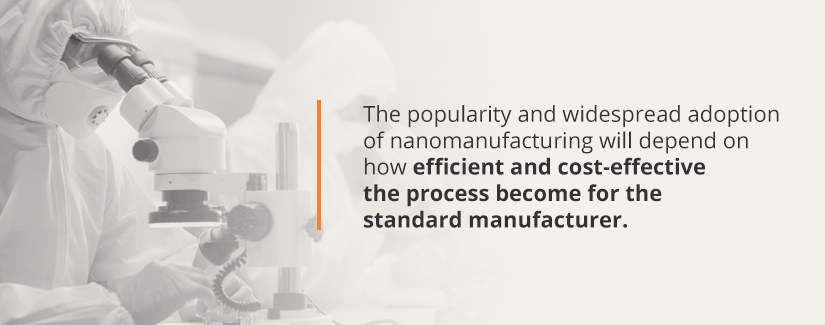
The popularity and widespread adoption of nanomanufacturing will depend on how efficient and cost-effective the process become for the standard manufacturer. If a product outsells all competing options when enhanced with nanostructured ingredients, this would incentivize further adoption of nanotechnology.
Companies, of course, will need to have the financial resources to implement nanotechnology. If the processes involved remain cost-prohibitive for smaller operations, further adoption could be inhibited for some years to come. If that remains a roadblock, the machines and tools used in the various processes will need first to become more readily available, as availability generally brings prices down.
For companies that remain reluctant, motivation could come via competing entities. For example, if a long-running apparel manufacturer sees a dip in sales due to the superior quality of garments provided by a competing clothing maker that uses nanotechnology, it could serve as an industry-wide wake-up call. Similar realizations are likely to occur among makers of electronics, paints, coats and auto parts.
Companies that initially lack the capital will ultimately need funding to launch a nanomanufacturing operation and make the practice profitable in the long run. As the incentives grow and investors step forth to fund such operations, some smaller companies looking for opportunities to try nanomanufacturing could find ways to join the revolution before it becomes mainstream.
Contact Global Electronic Services for Repairs
Whether your company is ready for a full embrace of nanomanufacturing, it is essential to have a place to turn for machine repairs and service work. At Global Electronic Services, we offer warranty-backed repairs on motors, electronics, hydraulics and pneumatics. Subscribe to our blog for the latest manufacturing updates and news.
